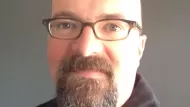Burning rainforests. Smog alerts. Gridlocked cities. Seabirds caked with oil. That's how it was, ladies and gentlemen, as we entered the '90s. This list of environmental peril is familiar still today, although we can cite some success fighting the smog. In this case, the quote is from a TV reporter in 1984, a character in a Ray Bradbury story called "The Toynbee Convector."
Burning rainforests. Smog alerts. Gridlocked cities. Seabirds caked with oil. That's how it was, ladies and gentlemen, as we entered the '90s.
This list of environmental peril is familiar still today, although we can cite some success fighting the smog. In this case, the quote is from a TV reporter in 1984, a character in a Ray Bradbury story called "The Toynbee Convector."
The title is so clumsy and unevocative that I'm constantly struggling to recall it and getting it confused with Bradbury's other, more famous time travel story (the one that popularized the idea of "the butterfly effect"). In The Toynbee Convector, however, time travel is just a device to move the story forward, not the central plot point.
The story is set in the year 3000, one hundred years after a man named Craig Bennett Stiles invented a time machine and rides it into the future. There, he finds a much improved world, a utopian society with beautiful architecture and planning and advanced technology. Stiles documents everything he can on film and brings it back home to his present (2000, if the back and forth has you addled). He destroys the time machine so as to not ruin this beautiful future (the aforementioned "butterfly effect" being a possibility) and dedicates his life to making the future become a reality, telling his story to the world.
Okay, <<SPOILER ALERT>>. If you don't want to learn what happens and want to read the story or watch the video for yourself, stop here.
After planting the seeds for the future, Stiles goes into self-imposed
exile, granting no interviews until the year 3000 where the story begins.
In that interview, he reveals to one reporter that the entire thing was
a hoax. He created meticulous models of a beautiful future for his
fraud, filming them to create a visual inspiration. The time machine
itself was just a prop, smoke and mirrors. He made the whole thing up because he felt that the world was suffering from a lack of vision and ambition. He quotes Arnold J. Toynbee,
an historian and a real person, although I'm not certain of the veracity of
the quote:
In order to survive, humankind must always rush to meet the future.
There is of course a lot in this utopian hoax turned real that would
make today's planner cringe. What about community participation, one
might ask. This is one man's utopia, which is nearly impossible to
reconcile with another's vision. For me though, this little story is a
wonderful metaphor for people like us who work to improve the world and
the built environment. There are too many people lacking positive
visions of the future. We should all be striving to tell stories, create
visualizations and persuade people that the world can be better.
A n interesting addendum: apparently, mysterious tiles have appeared around the world in a number of cities, saying things like, "TOYNBEE IDEA IN Kubrick's 2001 RESURRECT DEAD ON PLANET JUPITER." No one is entirely sure who is behind the tiles, which have been appearing since the 1970s.
n interesting addendum: apparently, mysterious tiles have appeared around the world in a number of cities, saying things like, "TOYNBEE IDEA IN Kubrick's 2001 RESURRECT DEAD ON PLANET JUPITER." No one is entirely sure who is behind the tiles, which have been appearing since the 1970s.
A message from the future, perhaps?

Pennsylvania Mall Conversion Bill Passes House
If passed, the bill would promote the adaptive reuse of defunct commercial buildings.

Planning for Accessibility: Proximity is More Important than Mobility
Accessibility-based planning minimizes the distance that people must travel to reach desired services and activities. Measured this way, increased density can provide more total benefits than increased speeds.

World's Largest Wildlife Overpass In the Works in Los Angeles County
Caltrans will soon close half of the 101 Freeway in order to continue construction of the Wallis Annenberg Wildlife Crossing near Agoura Hills in Los Angeles County.

Eviction Looms for Low-Income Tenants as Rent Debt Rises
Nonprofit housing operators across the country face almost $10 billion in rent debt.

Brightline West Breaks Ground
The high-speed rail line will link Las Vegas and the Los Angeles area.

Colorado Bans No-Fault Evictions
In most cases, landlords must provide a just cause for evicting tenants.
City of Costa Mesa
Licking County
Barrett Planning Group LLC
HUD's Office of Policy Development and Research
Mpact Transit + Community
HUD's Office of Policy Development and Research
Tufts University, Department of Urban and Environmental Policy & Planning
City of Universal City TX
ULI Northwest Arkansas
Write for Planetizen
Urban Design for Planners 1: Software Tools
This six-course series explores essential urban design concepts using open source software and equips planners with the tools they need to participate fully in the urban design process.
Planning for Universal Design
Learn the tools for implementing Universal Design in planning regulations.
























